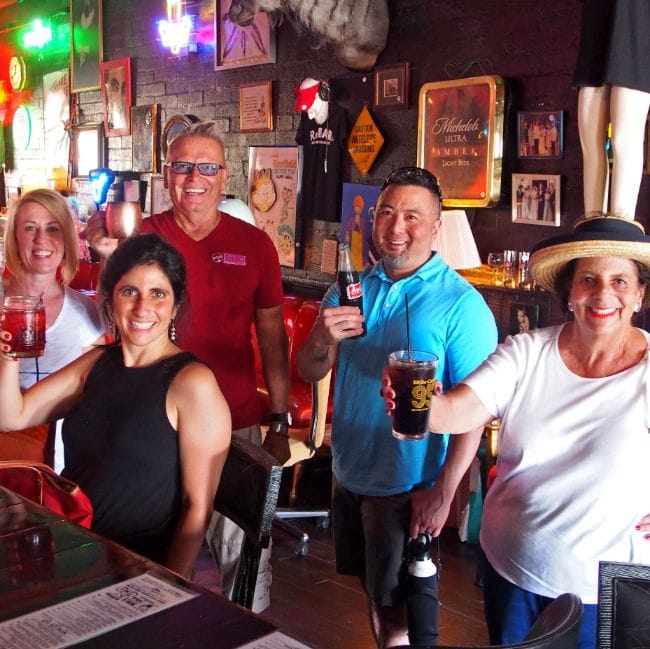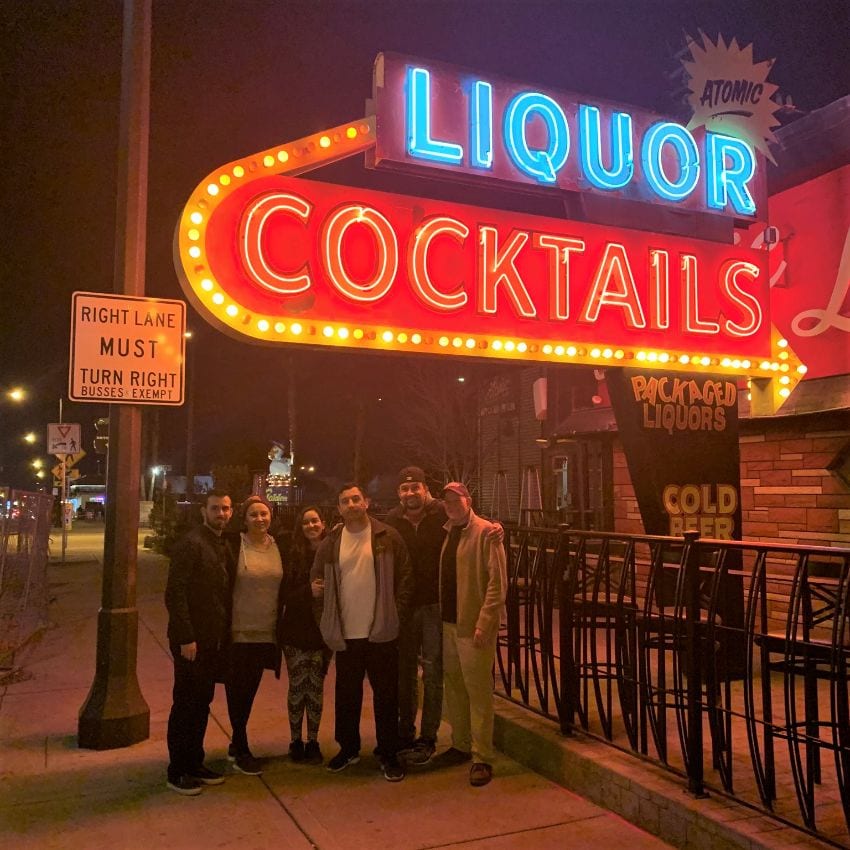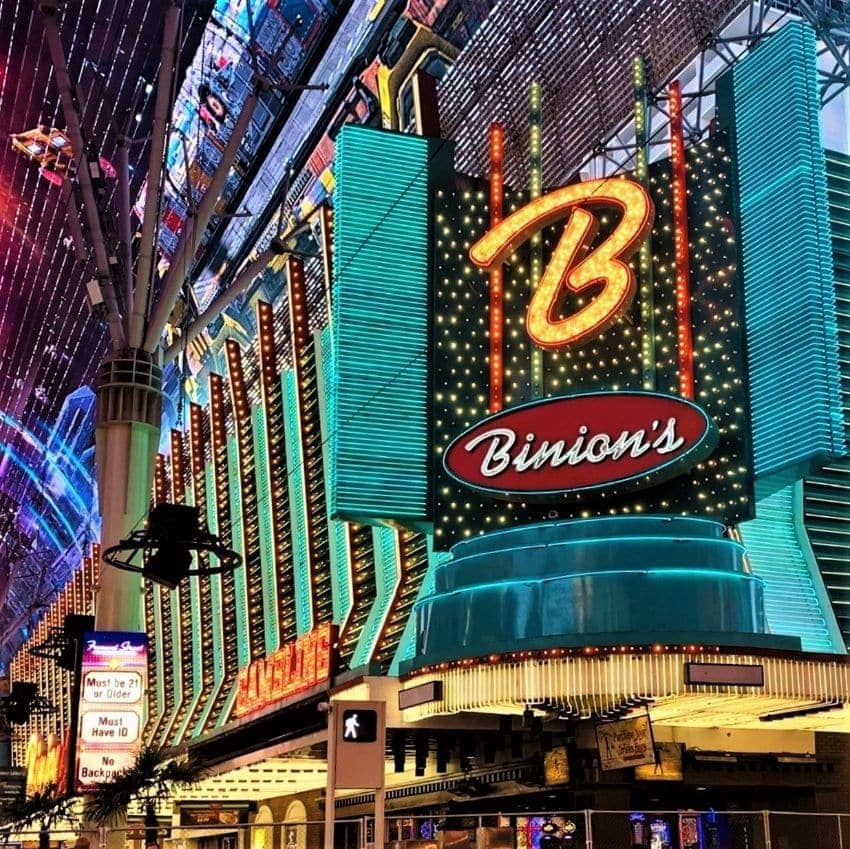Some time ago we offered a customized half-day walking tour of three cultural neighborhoods called The Ultimate 5-Hour Walking Tour of Downtown. It was billed as a walking tour with a bike component for which we used the Bike Share program of the Regional Transportation Commission. Once the tour was offered live, two adventurous couples from Albuquerque were the first to sign up for the half-day adventure.
We met up at 9 am near the 1950s Bow and Arrow sign in the collection of the Neon Museum Boneyard located in the Cultural Corridor on North Las Vegas Boulevard. There wasn’t time this day to tour the Boneyard collection, but we stopped by the museum’s visitor center and reviewed options for a nighttime visit when many of the signs are illuminated.
The Cultural Corridor, one of four arts neighborhoods Downtown, began about 30 years ago, envisioned at the time by city leaders as a kind of museum district. From the Boneyard, we walked a pace down the hill to the Las Vegas Natural History Museum, one of the oldest museums in the city. We toured the museum’s array of exhibits including a fantastic animatronic display of dinosaurs, a reminder that millions of years ago this part of America comprised the Jurassic Park era. We were taken by a replica of an odd-looking feathered dinosaur with claws, which our group fittingly called the Vegas Showgirl Dinosaur. The explanatory text noted that dinosaurs evolved into birds, prompting us to think about all those scary flying dinosaur movies.
Next door we stopped by the Old Mormon Fort State Park, a two-acre historical site that originally was a 2,000-acre rancho, the Stewart Ranch, the acreage on which the city was founded in 1905 as a railroad town in the middle of the Mojave Desert. The pastoral-like site includes a remnant of the old Las Vegas Creek that was fed by artesian springs; the name Las Vegas in Spanish translates to “the meadows” or the places where the wild grasses grow. We toured the Visitor’s Center that tells the compelling story of how this region was first explored in the 19th century as a part of the Old Spanish Trail from Santa Fe.
We trekked back up the hill, and at the top, looked back to the north and east, to the great plain that slopes down to the Colorado River Basin.
Heading Downtown, we arrived at the Mob Museum, aka, The National Museum of Organized Crime and Law Enforcement, housed in an impressive 1930s structure built during the era of Hoover Dam as a Federal Courthouse and Post Office. We checked out the lobby, now the museum entrance, and our tour goers noted a wall of original brass post office boxes as well as an old-fashioned window display with FBI Most Wanted Posters.
Soon we were on Fremont Street, named for John C. Fremont, an early explorer who mapped much of this part of the US in the early 19th century. Fremont is the original main thoroughfare of the city that served as the first commercial shopping street after the town was founded by the railroad; later, the street became the original gambling district of Las Vegas beginning in the 1930s.
Nine historic casinos are located on Fremont, dating from the 1940s to the present, and 25-years ago, the street was developed into a pedestrian plaza, the Fremont Street Experience, featuring the largest video screen in the world – extending 4 blocks and towering 90 feet above the sidewalk. Our group checked out the daily street performers, called Buskers, and we toured a few of the historic casinos that are much like living history museums. Being from Albuquerque, a city that has an historical Route 66 neon sign neighborhood, our visitors was taken by the spectacular neon signs that animate and bedazzle Downtown.
Upon leaving the Casino District, we checked in with Zoltar for a Vegas fortune, who shared these wise words, “age is simply a matter of mind, if you don’t mind, then it doesn’t matter.”
Then we trekked to Fremont East Entertainment District, a 40-block cultural and commercial neighborhood that’s been in redevelopment for the past decade or so with bars, restaurants, shops, murals, galleries, and festivals. We stopped by the famed Container Park with its signature Burning Man fire sculpture, the Praying Mantis, and had lunch in a lovey courtyard built around a children’s park.
Next stop on the tour was the 18b Arts district, about 12 blocks away. So, we checked out bikes from the RTC Bike Share station, took a route using the city’s designated bike lanes, rode through the Historic High School District, over near City Hall with its amazing collection of solar light trees, and arrived in the 18b Arts District, a grass-roots arts neighborhood that began to emerge 20 years ago.
We checked out some artist studios and galleries in the Arts Factory and stopped by the Burlesque Hall of Fame with a welcome and introduction in the lobby of the museum. Later we toured the vintage Vegas antiques district, and happily ended the 5-hour excursion with complimentary cocktails at the famed ReBar on Main Street, with toasts all around to the arts, culture, and the history of Las Vegas.



